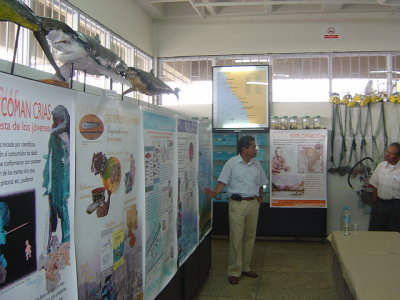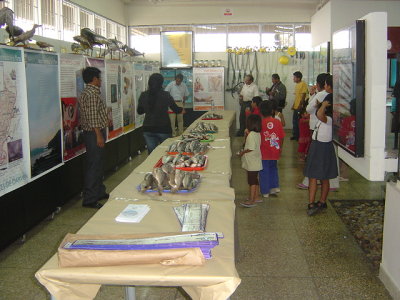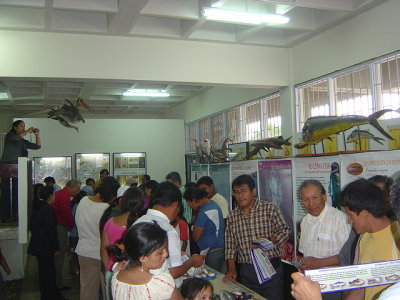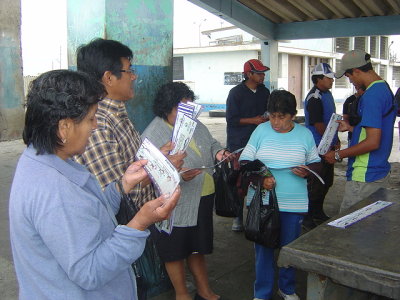Exhibition on sustainability of fisheries resources in Huanchaco - La Libertad, Peru
Chikipez a "tool to contribute to the sustainability of fisheries resources."
We note since several years a gradual decline of the available biomass of fish stocks at national level due to high fishing pressure. This results also in the decrease in the average size of the fishes in the catches and a significant increase of ever younger specimens. This affects the population structure of these species significantly, slows growth processes and jeopardises sustainability at population level.
It is important to raise awareness within the consumer public on issues of sustainability of fisheries resources, so that legally established minimum sizes of fishes in the catch are getting systematically respected, given that they correspond to the optimal size. This size gives the best biological and economic benefits, a situation that will achieve sustainability as R. Froese showed in a paper published in 2004.


You can look up the commercial fishes in the region of La Libertad in FishBase: Peruvian weakfish (Cachema - Cynoscion analis); Lebranche mullet (Lisa - Mugil liza); Lorna drum (Lorna - Sciaena deliciosa); Pacific menhaden (Machete - Ethmidium maculatum); Peruvian banded croaker (Suco - Paralonchurus peruanus); Eastern Pacific Bonito (Bonito - Sarda chilensis).
Within this context, the Instituto del Mar del Peru (IMARPE), through the Chikipez fish ruler, supports the idea of sustainability. Using the Chikipez fish ruler will result directly in conservation and optimum utilisation of the species, both nationally and internationally. Chikipez, is targeting the consumer of seafood products, retailers, industry authorities, media and community.
Activities performed
 The actions in IMARPE's regional centre in Huanchaco, near Trujillo and some 500 km north of the Peruvian capital Lima, on 10 December 2010, were related to a presentation on sustainability of fisheries resources in combination with a Mundus maris poster exhibition related to Darwin and the sea compared to today's situation, and a presentation of the Chikipez fish ruler adapted for Huanchaco. (all photos courtesy IMARPE).
The actions in IMARPE's regional centre in Huanchaco, near Trujillo and some 500 km north of the Peruvian capital Lima, on 10 December 2010, were related to a presentation on sustainability of fisheries resources in combination with a Mundus maris poster exhibition related to Darwin and the sea compared to today's situation, and a presentation of the Chikipez fish ruler adapted for Huanchaco. (all photos courtesy IMARPE).
Preparatory meetings were held with laboratory professionals to define the logistics for the use of the centre in Huanchaco, set up the biological material, and to give general instructions on the development of the practical part in the presentation of the Chikipez fish ruler.
 The day of the exhibition, from the early hours preparations were in place to have a welcoming environment and the demonstration material ready for the visitors.
The day of the exhibition, from the early hours preparations were in place to have a welcoming environment and the demonstration material ready for the visitors.
The presentation of the ruler was held in the auditorium of IMARPE Huanchaco, which was completely filled with visitors interested in fishery products in the presence of representatives of leading authorities of PRODUCE.
 During the exhibition, the use of the "Chikipez fish ruler" was explained so that the consumer can be sure the fish he or she buys, are adults and that the goal itself is not the Chikipez fish ruler itself, but to create awareness and inform the public about the negative effects to sustainable supplies of catching and buying juvenile fish, true to the motto "Don't eat babies".
During the exhibition, the use of the "Chikipez fish ruler" was explained so that the consumer can be sure the fish he or she buys, are adults and that the goal itself is not the Chikipez fish ruler itself, but to create awareness and inform the public about the negative effects to sustainable supplies of catching and buying juvenile fish, true to the motto "Don't eat babies".
At 17:30 pm the event ended, but not before inviting local authorities to take the campaign over as their own campaign to achieve sustainability of fishery resources in place.
 Finally, together with the laboratory professionals of Huanchaco the materials used in the presentation were taken down. Thanks are due to them for their important role and they should continue spreading the Chikipez fish ruler and encourage some local institutions to also take ownership of this campaign.
Finally, together with the laboratory professionals of Huanchaco the materials used in the presentation were taken down. Thanks are due to them for their important role and they should continue spreading the Chikipez fish ruler and encourage some local institutions to also take ownership of this campaign.
Jesús Gerardo Rujel Mena, Biologist








